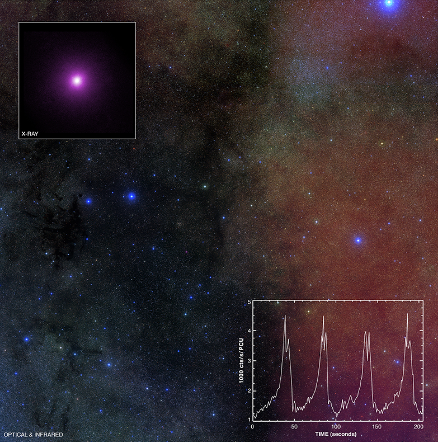
Master Thesis
Site: Merate (LC)
Duration
1 year
Tutor
Sara Motta
Contact
sara.motta AT inaf.it
Description
Background – X-ray binaries:
Throughout the Universe the combination of a deep potential well and an accretion disc, (which forms when matter is gravitationally captured by a celestial body) leads to the generation of fast, collimated outflows called jets.
This process, still poorly understood, occurs in proto-planetary discs and at the centre of galaxies alike, but around black hole (BHs) and neutron stars (NSs) it is taken to the extreme.
In a process known as feedback these so-called compact objects contrive to feed back to the surrounding space a large fraction of the energy and matter they could have swallowed, thereby acting to heat their environment rather than behaving only as sinks.
Feedback is important across a range of scales: from stellar-mass BHs and NSs in X-ray binaries (XRBs), to super-massive BHs powering the AGN, which via this process regulated the growth of massive galaxies.
The AGN and XRBs hosting BHs and NSs provide us with the best tests of General Relativity, but while the former evolve over decades to millenia, XRBs evolve rapidly, offering us the opportunity to probe on humanly accessible time-scales the energy and matter input/output around accreting objects.
The knowledge gained from studying XRBs can then be directly applied to AGN, where the inflow/outflow processes follow the same basic principles as around stellar-mass BHs.
Using observations from across the entire electromagnetic spectrum, and employing various techniques best-suited to extract the information stored in the data we investigate the physics of the accretion and outflow generation processes in X-ray binaries, with the aim of understanding the nature of such processes and the link between them both on stellar-mass scales, and on super-massive scales.
The thesis – GRS 1915+105 is one of the best-studied Galactic BH X-ray binaries. Located at a radio parallax distance of ~8.6 kpc, GRS 1915+105 hosts a stellar mass black hole of approximately 12 solar masses, believed to accrete erratically close to its Eddington limit. This system was the first Galactic BH observed to display relativistic super-luminal radio ejections, and it is still considered the archetypal Galactic source of relativistic jets.
GRS 1915+105 appeared as a bright transient in August 1992 and over the past 30 years, it has alternated between extraordinary activity phases with strong and variable radio and X-ray emission, and long periods of time of reduced activity, with relatively low radio and X-ray fluxes.
In July 2018 GRS 1915+105 entered an unusually extended low-flux X-ray phase, interrupted by a few months during which the source was extremely active in radio, but remained dim in the X-rays, most likely as a consequence of presence of absorbing material local to the source that was shielding the X-ray emission. More recently, at the end of 2021, GRS 1915+105 entered an even lower phase, which is characterized by the absence of any variability at all wavelength, and an X-ray and radio luminosity consistent with an unusually high quiescence.
The aim of this thesis is to characterize the emission of GRS 1915+105 during the years from 2018 onwards, to understand the properties of the accretion flow and how they are connected with those of the jet observed in radio. We will study the X-ray emission using unpublished data collected by the Swift satellite and the NICER mission to reveal the physical processes at the base of the behavior of the source, and we will compare them with the properties of the radio emission observed with the MeerKAT radio telescope and the AMI-Large Array.
The results of this analysis will be put in context of what is known of GRS 1915+105 and of X-ray binaries in general.
